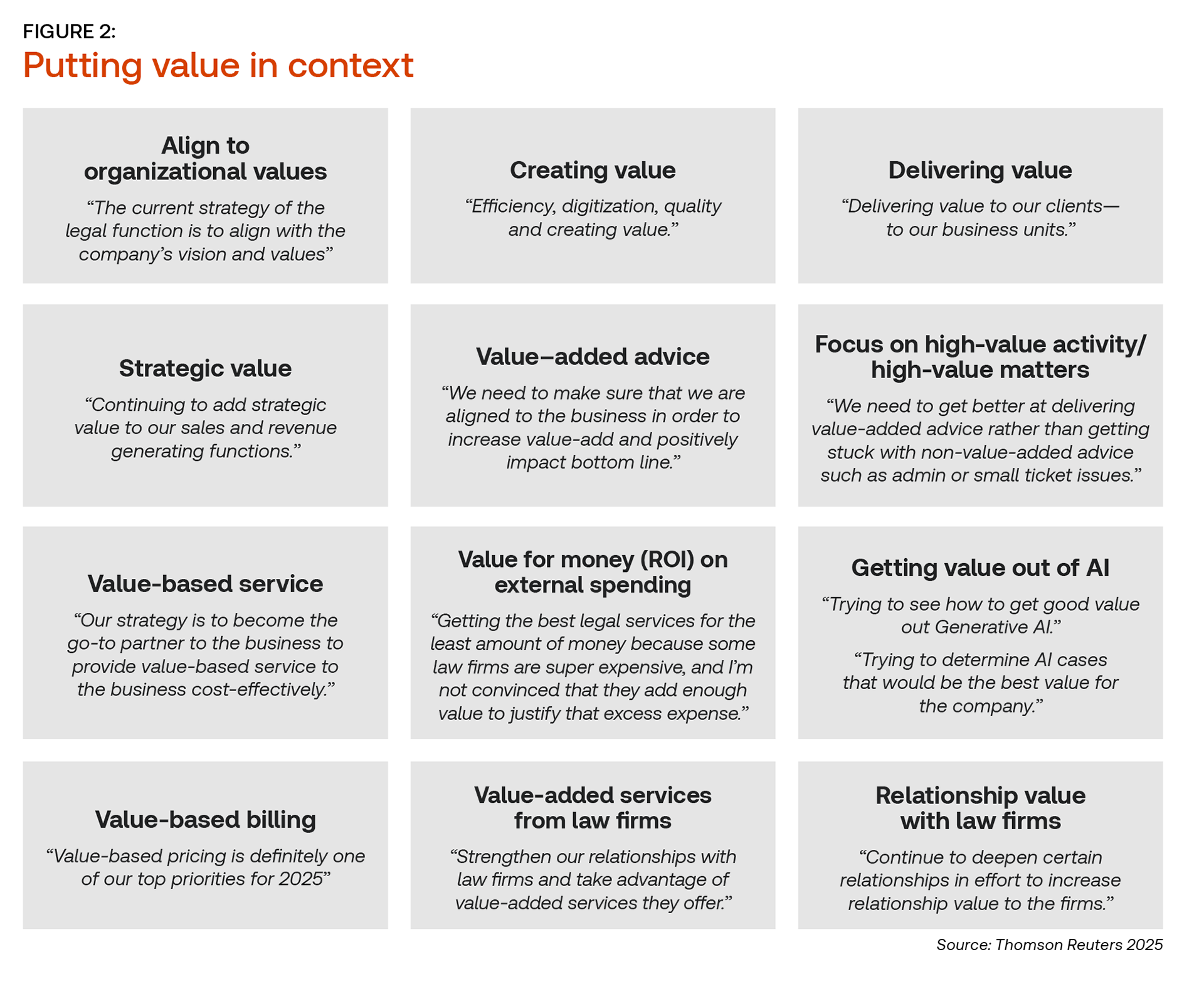The ability to define “value” is critical for corporate general counsel, not only so they can communicate their performance back to the business but so they can set expectations for outside counsel — however, landing on a definition is fraught with challenges
The recently released 2025 State of the Corporate Law Department Report led with an interesting finding. Corporate general counsel (GCs) mentioned the concept of value three times as often in the research for this year’s report than they had in the prior year. That is an incredibly significant point that must be understood for the scope of the challenge GCs face in defining value to fully come into focus.
The majority of the research conducted for the State of the Corporate Law Department Report every year isn’t based on survey responses. Rather, it’s based on one-on-one interviews with GCs who are answering open-ended questions — nearly 2,500 GCs from all across the globe were interviewed last year alone. Their answers give a fairly clear picture about what’s top of minds for them.
With that in mind, it’s quite remarkable to see a thrice-fold increase in the number of mentions of the concept of value emerging from these interviews. It’s not a case of GCs selecting an answer from a pre-populated survey list; rather, three times as many GCs brought up the idea of value of their own accord.
Avoiding buzzwords
Value is a rather amorphous and subjective concept. What one person values deeply, another may dismiss out of hand.
Indeed, the Merriam-Webster’s online dictionary provides eight different definitions for the word value as a noun, and an additional three as a verb or adjective. Definitions range from concepts of monetary worth to utility, and even the duration of a musical note or the relative darkness of a color. With this broad spectrum of definitions available, it is no wonder that GCs find it challenging to clearly articulate what they value.
The following figure from the report illustrates this more clearly:

Unless a GC can clearly articulate what they mean when they talk about value, there is a genuine risk of the word losing all meaning.
Understanding the spectrum of value
From the table above, perhaps my two favorite examples to illustrate the need for clarity in defining value are the top and bottom boxes on the left-hand side. Most often when we think of value in the context of legal work, we think about the idea laid out in the middle of the table — value for the money spent. Indeed, we know that of all the metrics tracked by corporate GCs, metrics related to their total budget — and in particular their spend on outside counsel — are the most frequently tracked.
If our definition of value stopped there, measuring and communicating value would be a relatively easy exercise. However, the top and bottom boxes on the left-hand side very quickly show that such a definition is far too limited.
On the top left of the table is the idea of aligning to organizational values. This definition of value is far different than just dealing with money. Rather, it speaks to what the organization as a whole finds important or intrinsically desirable. Thomson Reuters, like most organizations, dedicates full pages and more to our own statements on values, even articulating a robust set of Trust Principles that guide our work. For GCs, aligning to their organization’s values plays a critical role in how they understand and enable the business. It can be more challenging, however, to communicate that need for alignment to outside counsel and other legal services providers.
To get there, we must contrast the top box on the left side of the table with the one on the bottom left in which the idea of value is incorporated into a phrasal adjective. This example of value — citing value-based pricing — treads much closer to the common monetary understanding, but even then, understanding this example is not quite so simple.
True, value-based billing arrangements, often called alternative fee arrangements, are largely based on how much the work will cost. Yet, the value the firm is hoping to receive in such matters also depends on other factors, such as:
-
-
- how quickly the work is completed
- whether the actual outcome of the work matches the desired outcome
- the value of the settlement or judgement compared to the claimed amount
- how effectively protracted litigation was avoided
- the cost of the matter compared to similar past examples
- the innovation displayed in solving the legal issues
- and myriad other potential considerations.
-
In short, what is valued in a particular legal matter under a value-based billing arrangement can be a moving target. The concept of value-based billing might be generally understood, but the actual definition of the value of any given piece of legal work will vary.
Communication is key
Recognizing that the definition of value can be a shifting concept, it is vital that GCs facing this challenge engage in a high degree of communication. One of the action items laid out in the 2025 State of the Corporate Law Department report is a call for GCs to make settling on a definition of value — or at least the framework of a definition — a key focus for 2025.
As the report states:
“It should be a goal for each law department to determine what value means to them and to promulgate that definition to their key stakeholders. By doing so, GCs will accomplish several important tasks. First, they will give internal stakeholders in the business a better understanding of exactly what the legal function is hoping to contribute to the business’s broader interests. Second, it will clarify for those within the in-house legal team itself what goals and objectives they should be working to meet. Third, it will communicate to outside counsel and other service providers what those vendors should be working to deliver to the in-house legal team as the direct client.”
Of course, this is not an easy task; but it is one which will help GCs ensure that they are capturing what matters most to the business and making those efforts known to key stakeholders.
You can download a copy of the full 2025 State of the Corporate Law Department Report here







